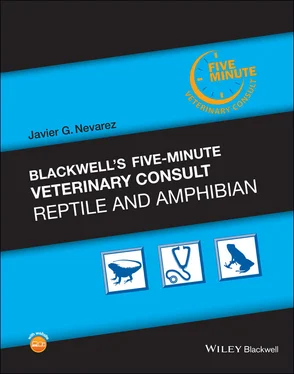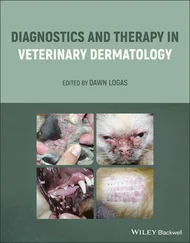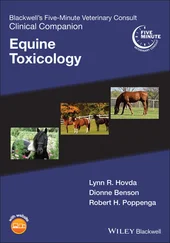Hematology and Biochemistry
A chemistry panel is essential to help identify other possible underlying disease processes such as dehydration and NSHP.
In addition to Ca and P, Mg levels should be documented as Mg also plays an important role in Ca homeostasis.
Levels of Mg below 1 mg/dl and/or ionized Ca below 1 mmol/l should be considered deficient.
Hypercalcemia and hyperphosphatemia are common findings in reproductively active female chelonians.
Hyperproteinemia, anemia, and hypoglycemia may also be identified.
CBC: leukocytosis may be observed but does not always occur, especially in chronic cases. Leukopenia may be present if sepsis has ensued.
During the acute stages, egg yolk coelomitis presents as yellow to white, viscous, free fluid within the cavity.
Fragments of more solid yolk may also be free floating within the cavity.
Chronically more adhesions develop and form a white fibrinous to fibrotic membrane on the serosal surfaces of the organs.
The lesions are often severe enough that surgical repair is not possible.
Many cases are diagnosed postmortem.
 TREATMENT
TREATMENT
APPROPRIATE HEALTH CARE
Animals with yolk coelomitis must undergo surgery in an attempt to correct the condition, but it is often fatal.
In most chelonians, yolk coelomitis is a chronic presentation.
The goal of exploratory coeliotomy is to determine the severity of the diseases and whether successful lavage and cleaning of the cavity can be performed.
Any free‐floating material must be removed and the cavity lavaged copiously to remove the protein.
If it can be accomplished, an ovariosalpingectomy is performed.
Surgery can be performed either through the prefemoral fossa, aided by an endoscope or by plastronotomy.
A plastronotomy will allow for better lavage and evaluation of the cavity, but it carries a higher risk of postoperative complications.
Any underlying abnormalities (e.g., NSHP, dehydration, anemia) must be treated accordingly.
These animals must also receive anti‐ inflammatories and analgesics, as the reaction to the yolk and subsequent adhesions are extremely painful.
Dietary deficiencies must be corrected with special emphasis on UVB light and oral Ca supplementation.
CLIENT EDUCATION/HUSBANDRY RECOMMENDATIONS
Clients should be encouraged to seek veterinary care of chelonians early on to establish individual baseline values and confirm the sex of the animal.
Egg yolk coelomitis occurs as a sequel to multifactorial causes, so all husbandry deficiencies must be corrected, with emphasis on UVB light, calcium supplementation, nutrition, temperature, humidity, and provision of adequate nesting substrate.
Chelonians should be weighed at least weekly to document any sudden weight increases that may be indicative of follicular development that may lead to yolk coelomitis.
 MEDICATIONS
MEDICATIONS
DRUG(S) OF CHOICE
Meloxicam 0.5 mg/kg PO, IM, SC q24–48h
Morphine 1–10 mg/kg IM, SC q24h
Hydromorphone 0.2–0.5 mg/kg IM, SC q12–24h
Morphine and hydromorphone can cause sedation and respiratory depression.
Dose and frequency of administration should be refined based on the patient’s response.
 FOLLOW‐UP
FOLLOW‐UP
PATIENT MONITORING
If an underlying disease process is diagnosed, appropriate follow‐up diagnostics should be performed to determine improvement of that condition or the need to alter therapy.
A re‐evaluation within 1–2 weeks of surgery is recommended to evaluate the surgical site and overall recovery.
EXPECTED COURSE AND PROGNOSIS
The overall prognosis will depend on the speed with which the disease is recognized by the owners and diagnosed and treated by the veterinarian.
Per‐acute to acute cases have a fair prognosis.
Chronic cases have a grave prognosis.
 MISCELLANEOUS
MISCELLANEOUS
COMMENTS
N/A
N/A
Egg coelomitis/peritonitis
Yolk coelomitis/peritonitis
Ca = calcium
CBC = complete blood count
CT scan = computed tomography
GI = gastrointestinal
IM = intramuscular
Mg = magnesium
MRI = magnetic resonance imaging
NSHP = nutritional secondary hyperparathyroidism
P = phosphorus
PO = per os
SC = subcutaneous
Pollock C. Reproductive disease in reptiles: twelve key facts. LafeberVet, September 23, 2012. https://lafeber.com/vet/reproductive‐disease‐in‐reptiles‐ twelve‐key‐facts
AuthorJavier G. Nevarez, DVM, PhD, DACZM, DECZM (Herpetology)
Eimeria
 BASICS
BASICS
DEFINITION/OVERVIEW
Eimeria are apicomplexan parasites characterized by oocytes having four sporocysts that each contain two sporozoites. Eimeria are typically intracytoplasmic parasites, although some have been described as having intranuclear development. They rarely cause disease and commonly form a normal component of the GI flora of reptiles.
Over 200 species of Eimeriahave been described in reptiles and, with the advent of molecular techniques, the rate of species discovery is increasing.
Eimeriahave a direct lifecycle, with infective stages passed in the feces of the host. Eimeriacan be found in the gallbladder, bile ducts, and intestinal epithelium of snakes, lizards, and crocodilians.
Most reports of illness associated with Eimeriainfection are from captive animals that have been housed under suboptimal conditions.
Virulence may be exacerbated by a range of intrinsic and extrinsic factors such as concurrent disease and infective dose.
Disseminated visceral coccidiosis due to an unspecified Eimeriasp. was the cause of death of two of Indo‐Gangetic flap‐shelled turtles (Lissemys punctata andersonii).
An unspecified intranuclear coccidia has been responsible for the deaths of a range of chelonian species but, to date, identification to genus level has not been possible.
Disease usually occurs under circumstances of high stocking density, unsanitary conditions, and maladaptation of wild animals entering captive situations.
Most animals are asymptomatic carriers but, when disease occurs, clinical signs are reflective of host‐cell destruction and are dependent on site of infection.
Читать дальше

 TREATMENT
TREATMENT MEDICATIONS
MEDICATIONS FOLLOW‐UP
FOLLOW‐UP MISCELLANEOUS
MISCELLANEOUS BASICS
BASICS










